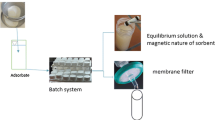Abstract
Adsorption was measured and compared for the uptake of zinc, iron, lead, copper and ammonium onto clinoptilolite- and mordenite-rich tuffs of Slovakian and Chinese origin for both the natural and near homoionic Na form as well, using the radioanalytical and spectrometric determination. The higher quality of Slovakian clinoptilolite-rich tuff has been proven to be effective for a potential lead and ammonium removal in native form, while parent tuff in Na exchanged variety may be proposed for even Fe(III) species removal out of water. The raw and Na-exchanged mordenite-rich tuffs proved subsequently more or less similar selectivity, however lower adsorption capacity. Chinese clinoptilolite-rich tuff has not proved any exceptional high adsorption performance towards Fe(III) species. The data obtained from the adsorption experiments at 7–75 °C were used for calculation of some thermodynamic parameters—Gibbs free energy, activation energy, standard enthalpy and entropy, too.





Similar content being viewed by others
References
Podkoscielny P, Dabrowski A (2001) Adsorption contribution to the protection of the Human environment. Annales Uni. M.C. Sklodowska, Chemia, p 3–29
Rudolfs W (1947) Phosphate and sewage treatment: quantities of phosphates. Sew Works J 19:43–47
Kazemian H (2012) Environmental applications of natural zeolites, Chap. 10. In: Inglezakis VJ, Zorpas AA (eds) Handbook of Natural Zeolites, Bentham-e-Books, pp 214–237
Inglezakis VJ, Poulopoulos SGAdsorption (2006) Ion Exchange and Catalysis: Design of Operations and Environmental Applications. Elsevier, Amsterdam
Chelishchev NF, Volodin VF, Krjukov VL (1988) Ionoobmennye svoistva prirodnych vysokokremnistych ceolitov. Nauka, Moskva, p 128
Tsitsishvili GV, Andronikashvili TG, Kirov GN, Filizova LD (1992) Natural Zeolites. Ellis Horwood, Chichester
Ming DW, Bata DJ, Golden DC, Galindo C, Henninger DL (1995) Natural Zeolites ′93. In: Ming DW, Mumpton FA (eds) Occurrence, Properties, Use. Int. Natural Zeolites Assoc., Brockport, p 505
Galamboš M, Magula M, Daňo M, Osaský M, Rosskopfová O, Rajec P (2012) Comparative study of strontium adsorption on dioctahedral and trioctahedral smectites. J Radioanal Nucl Chem 293(3):889–897
Hårleman C, Jacks G, Rybeck B (2009) The use of a clinoptilolite-based filter in emergency situations, Desalination. Desalination 248:629
Kurucová S, Blažík T, Kuruc J (2002) Geographic aspects of radioactive contamination of Chelyabinsk region on the base of the Mayak nuclear production and waste reprocessing activities, Omega Info Bratislava, ISBN 80-967741-4-X, 63 p. (in Slovak)
Šamajová E, Kraus I (1985) Distribution of smectites and zeolites in the West Carpathians. In: Proc. 5th Meeting of European Clay Groups, Charles University Praque, pp 321–328
Hudec P (2012) Texture of Solids, Publ. by Slovak Technical University in Bratislava, ISBN 978-80-227-3698-5, 311 p (in Slovak)
Chmielewská E, Lesný J (2012) Selective ion exchange onto Slovakian natural zeolites in aqueous solutions. J Radioanal Nucl Chem 293:535–543
Chmielewská E, Lesný J (1997) A natural ion exchange medium for radioactive 59Fe fallout abatement. J Radioanal Nucl Chem 223:243–245
Steed JW, Turner DR, Wallace KJ (2007) Core Concepts in Supramolecular Chemistry and Nanochemistry. Wiley, Chichester
Guibal E (2004) Interactions of metal ions with chitosan-based sorbents: a review. Separation Purification Technology 38:43–74
Breck DW (1974) Zeolite Molecular Sieves. Structure, Chemistry and Use. Wiley, New York, London, Sydney, Toronto, p 771
Galamboš M, Suchánek P, Rosskopfová O (2012) Sorption of anthropogenic radionuclides on natural and synthetic inorganic sorbents. J Radioanal Nucl Chem 293:613–633
Acknowledgments
The project of natural zeolites characterization is currently funded by the Slovak Scientific Council VEGA (Project # 1/0185/12).
Author information
Authors and Affiliations
Corresponding author
Rights and permissions
About this article
Cite this article
Chmielewská, E. An approach to physical characterization of fundamental ion exchange and adsorption behaviours of tuffaceous minerals in aqueous solutions of some environmental pollutants. J Radioanal Nucl Chem 298, 1023–1029 (2013). https://doi.org/10.1007/s10967-013-2469-z
Received:
Published:
Issue Date:
DOI: https://doi.org/10.1007/s10967-013-2469-z



